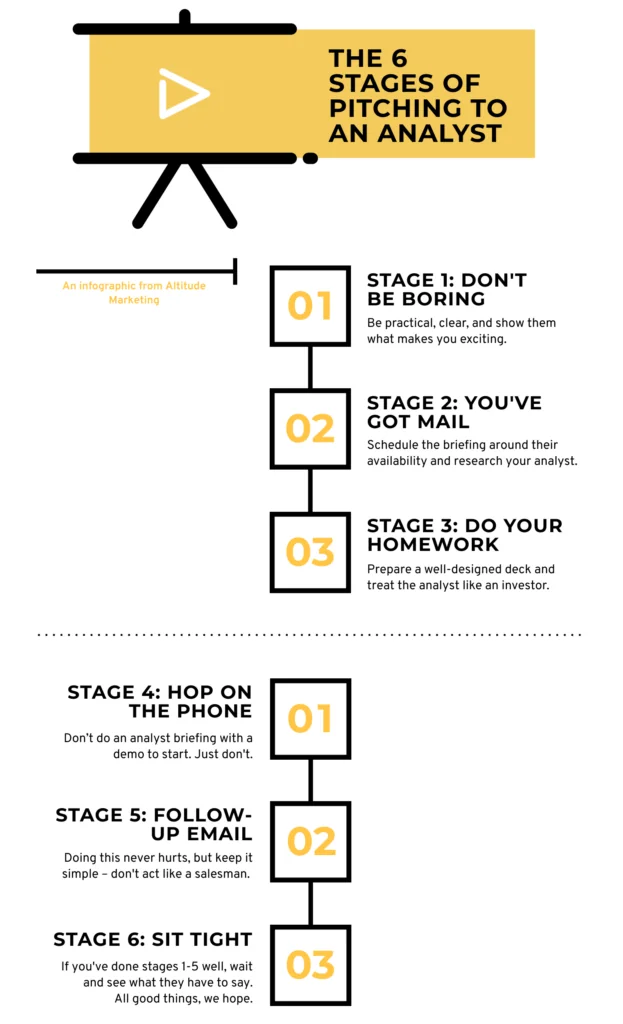Note: This blog was updated October 2024.
Analysts can be one of the toughest crowds for product marketers to impress. Getting their attention can be tricky, but it’s what you do with it that will make or break a briefing.

Analyst Briefing Best Practices: 6 Steps to Success
In this post, we’ll break down best practices for nailing your next analyst briefing. But first, let’s talk a bit about what an analyst briefing is, and what it can get you.
What Is an Analyst Briefing?
Every analyst firm or large consultancy worth its salt will offer once-a-year calls – often called “vendor briefings” – to technology providers, software companies and other companies that make products their clients might need.
These meetings are explicitly not about getting free advice to help you improve your product. (That’s the stuff you pay an analyst $30,000 or more to get.) They’re also not necessarily going to land you in the Magic Quadrant or Wave.
What free analyst briefings can potentially do is:
- Put you on the radar of key industry influencers
- Let you field test new messaging and positioning
- (Maybe) get you recommended to an analyst’s buying client
For example, we once had a client brief an analyst on their web-based product. A week later, a major software company representative asked the analyst for a recommendation for exactly what our client provided. Flash forward two months … a million bucks in the door.
That’s why good analyst relations are so important.
This whole thing may seem a little intimidating, but there’s no reason to panic. In this infographic, we’ve outlined the six stages of how to pitch to an analyst – the right way.

Stage 1: Secure the Briefing
You can’t nail an analyst briefing without first securing it. That means getting in touch the right way – and making a good first impression.
If you have a PR team, it’s a good idea to have them handle this initial outreach. (They’ve probably done it before.)
But if you’re an entrepreneur or bootstrapper, here’s how to get in touch with analyst firms.
Stage 2: You’ve Got Mail
If you were interesting, thorough and professional in your analyst briefing request, you’ll probably get an email saying something like:
“Jim has received your submission. He is happy to take a briefing with you. Please select from the times below.”
Woo-hoo!
Now schedule the briefing.
When scheduling, it’s important to accept one of their preferred times. You have to cater to them, because at the end of the day, you don’t get a ton of analyst hits. There simply aren’t that many out there.
Analysts are important influencers and thought leaders. So make one of their time slots work. Rescheduling a meeting or two will 100 percent pay off in this case.
Once you’ve gotten a response and a calendar invite, you’ll know who the analyst you’ll be pitching is.
Look them up. Do your research.
Connect on LinkedIn if you can. Study their resume. Check out any writing and speaking engagements they’ve done in the past. Doing this will give you a good idea on how they approach things, what they’re into, and what their personality is like.
All of those details will become beneficial in the next of the six stages of how to pitch an analyst.
Analyst Contact Info
Most analysts have their contact information easily laid out on their website, with links to specific forms you’ll need to fill out to get in touch with them. Here are links to eight major players’ vendor briefing request forms and instructions.
Gartner
Forrester Research
IHS Markit
IDC
HfS Research
Everest Group
451 Research
Frost & Sullivan
The important thing to keep in mind is that you’re playing by their rules. A free analyst briefing is usually only offered once a year to each vendor, and the analyst has the right to turn you down flat. So follow their directions.
The second thing to keep in mind: Don’t be boring. Analysts want to hear something new. They’ve seen hundreds of pitches, but it’s important for them to hear from new companies and keep their knowledge up-to-date.
Ask yourself this: What makes you different? What makes your product sexy? What makes you seem like a visionary? This is the stuff you include in your initial briefing request.
It needs to be fresh. Interesting. Exciting.
With that being said, you also need to make sure you:
Cover what it is that you do
Be clear about your place in the market
Make it seem like you’re full of value (because you are)
Stage 3: Do Your Homework
Come into the briefing with a deck. It doesn’t necessarily need to be in PowerPoint, but it does need to be professionally designed.
You’re making a first impression on an industry influencer. That means no generic templates, and no freakin’ Calibri. Make the deck look professional.
In terms of content, you’ll essentially want to treat the analyst like an investor. Even though they cover your space, they’re probably not as well versed as you. And they definitely won’t have the same questions as a buyer.
With these facts in mind, you’ve got to lay out in your briefing:
Your provenance. Tell the analyst what you’re all about and where you came from.
The market challenge. Emphasize that there’s a specific problem in the market that needs to be solved.
Potential benefits of solving this problem and why it matters,
Your right to win. This is why you’re technically and ideally suited to meet this challenge.
The killer feature. This is something within the software product or solution (a relatively small piece) that’s sexy. It’s the kind of feature you proudly flaunt in commercials and advertisements. For example, what’s the killer feature of the iPhone 11? Those triple cameras.
You’ll usually only have 30 minutes. Make sure you’re going to get to the point fast, hold their attention and leave them walking away impressed.
Stage 4: Actually Do the Analyst Briefing
Do you recognize the one thing we haven’t mentioned yet in our six stages of pitching to an analyst?
A demo.
Well, there’s a reason we haven’t mentioned it at all up until now:
Don’t do a damn demo.
Just don’t.
If or when an analyst asks about what your product does during the call, then it’s fine to show it off. But don’t start the analyst briefing with a demo. Treat it more like an investor pitch.
Imagine it this way: You’re a visionary speaking to another visionary. You’re not talking about what this button and that button does. You’re laying out your theory on how to solve the business problems of the future.
Sell an idea. A vision.
They’ll sure as heck appreciate that more than a demo.
Stage 5: Follow Up
Never hurts to send a follow-up email.
But in doing so, don’t try to sell to them and “close a deal.”
Instead, say thank you, show them that you value their time, and send them the resources that you mentioned during the call. It’s important to treat the analysts as thought leaders, because that’s truly what they are.
(Or sometimes what they think they are. Whatever.)
Instead of acting like a salesman in the follow up to your analyst briefing, simply leave the door open for further conversation in the future without being too pushy.
Simplicity, in the right context, is always appreciated.
Stage 6: Sit Tight
Short of paying five figures to one of these market research/consulting companies, you’re never guaranteed results form an analyst.
So the magic formula that you need to remember when pitching to an analyst is:
Good briefings = good business
When someone comes to an analyst for a referral, they might mention you — if you nailed your presentation, prepared well … and didn’t do a demo.
If you’ve followed these analyst steps correctly, you’ll be well on your way to creating beneficial relationships with analysts, boosting your presence, and standing out in your industry.
(No demos.)
If you’re looking for the perfect team to help you find your strengths and make your product or solution stand out, we know exactly how to help you. Contact us or call 610-421-8601 x122 to get in touch with one of our marketing experts today.
Steps | Implementation | Impact | Time to Implement |
1. Secure the Briefing | Reach out to analysts through proper channels (e.g., contact forms), highlighting what makes your product/company unique and valuable. | Gets you on the analyst’s radar and allows you to present your messaging. | 1-2 weeks |
2. Schedule the Briefing | Accept one of the analyst’s preferred time slots, and research the analyst’s background and interests. | Allows you to cater the briefing to the analyst’s interests and style. | 1 week |
3. Do Your Homework | Prepare a professional deck laying out your company’s provenance, the market challenge, the benefits of solving it, your competitive advantages, and a “killer feature.” | Ensures you present a compelling, well-structured pitch to impress the analyst. | 2-3 weeks |
4. Actually Do the Briefing | Deliver your pitch like an investor presentation, focusing on vision and ideas rather than a product demo. | Positions you as a visionary and thought leader in the analyst’s eyes. | 30 minutes |
5. Follow Up | Send a thank-you email with any referenced resources, but avoid hard-selling. | Maintains a positive relationship and leaves the door open for future conversations. | 1 day |
6. Sit Tight | Wait for potential referrals or recommendations from the analyst to their clients. | Can lead to new business opportunities if the briefing was successful. | Ongoing |
FAQs
1. Why are analyst briefings important?
Analyst briefings are a chance to connect with influential people in your industry. If the analysts like what they hear, they may recommend your product to their big company clients. This can potentially lead to new business opportunities for you down the road.
2. How do I set up an analyst briefing?
First, you’ll need to find the proper contact forms on the analysts’ websites. Fill these out, highlighting what makes your product special. If the analysts are interested, they’ll offer you some available time slots to present. Accept one that works for your schedule.
3. What should I cover in the briefing?
Your briefing should feel like you’re pitching to an investor, not doing a product demo. Cover topics like your company’s background, the problem you’re trying to solve, the benefits of your solution, your competitive advantages, and any standout product features. But keep the focus on your big-picture vision, not tiny product details.



